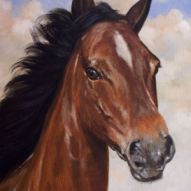How To Write Descriptions People Want to Read: Horses
 This is the second in the “How to Write Descriptions” series (updated from my last post on this topic here). This one is on horses. I had to write about horses in the wild for one of my novels so I spent a lot of time reading about and watching them. Here’s what I learned:
This is the second in the “How to Write Descriptions” series (updated from my last post on this topic here). This one is on horses. I had to write about horses in the wild for one of my novels so I spent a lot of time reading about and watching them. Here’s what I learned:
they recognize the distant approach of friend or foe
they anticipate storms and earthquakes
when they’re happy, they drop their heads, flip them high, maybe make a high and full skyward circle with their noses. Their behavior is eager, interested, alert, playful, responsive
they can laugh–not a human laugh. Horses curl their upper lip, fully exposing their upper front teeth. They do a good deal of prancing with raised tail.
they will reply to you with raised head, arched neck, muzzle down; they’ll prick their ears forward and might even take off at a dead run
when they’re angry, their ears lie back, tail swishes as if at a fly; when they’re angrier, their hindquarters tense; their ears become even closer to their skull, tail more vigorous, and their rear hoof raises slightly
they show pride by prancing with ears straight forward, nostrils flaring, tail up, head pointed downward on arched neck
they show interest when their nose, eyes, ears point straight ahead at the object of interest, circling in curiosity

they show eagerness by stamping their front foot, then hind foot, shaking their head, dancing sideways, ears turned back to rider or forward to where he is going
when they’re healthy, their coat glows–reflects light; their mane and tail are soft, not matted, lumpy, or coarse, and their hindquarters are dappled with color in summer
when they’re in pain, they shrug or shiver the affected muscle, slap their tail as close as possible to the area of discomfort, swing their head backward to hit the offended part with their muzzle; when it’s worse, their ears turn back toward the pain, eyes look blank, and they groan; when it’s severe, they groan, tremble and sweat
when they’re sharp, they are eager, with a glowing appearance
when they’re bereaved, they move around the stall in restless circles, head out the door; their ears prick forward looking for their companion, and they sniff the air for the missing scent
when they’re frightened, their ears, nose, eyes point straight at the object of concern; they loudly sniff, furrow their eyes; they’re light-footed, dancing restlessly in place; they try to flee, awash in sweat, whites of eyes visible; they breathe heavily with much nostril movement and frightened nickers; their head hangs almost to the ground, eyes closed, ears flopped down motionless to sides; they won’t eat or drink
when they’re bored, they shift their weight restlessly; hold their head sleepily down and then move it actively; they become very mouthy
when they’re sick, they are listless, inactive, less responsive; their coat turns dull; when they’re very sick, they lower their heads and are even less responsive
–Beautiful artwork used with permission of Horse Collectionary.
More animal descriptions:
How To Write Descriptions People Want to Read: Wild Animals
Filed under: descriptors, nature Tagged: animal descriptions, characterization, horses, natural settings


Published on April 18, 2014 00:39
No comments have been added yet.



